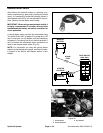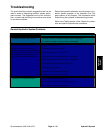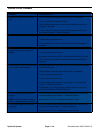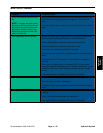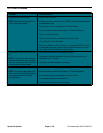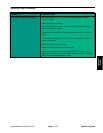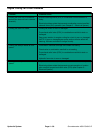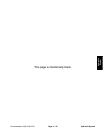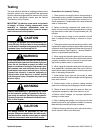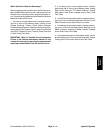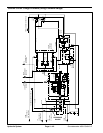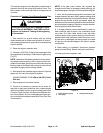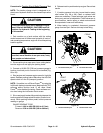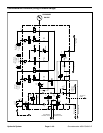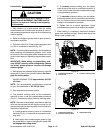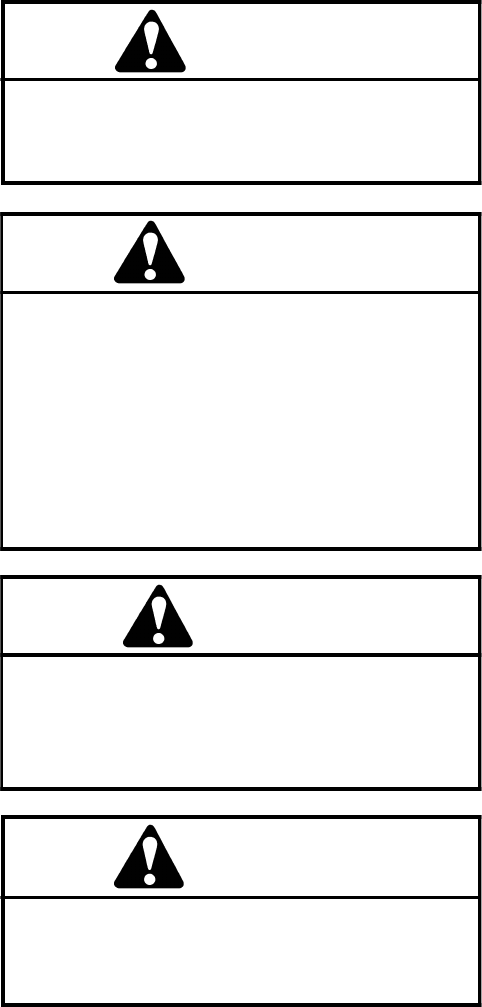
Groundsmaster 4000--D/4010--DHydraulic System Page 4 -- 40
Testing
The most effective method for isolating problems in the
hydraulic system is by using hydraulic test equipment
such as pressure gauges and flow meters in the circuits
during various operational checks (see the Special
Tools section in this Chapter).
IMPORTANT: All obvious areas such as hydraulic
oil supply, oil filters, binding components, loose
fasteners or improper adjustments must be
checked before assuming that a h ydraulic compo-
nent is the source of the problem.
CAUTION
Failure to use gauges with recommended pres-
sure (PSI/bar) rating as listed in test procedures
couldresult in damage tot he gaugeand possible
personal injury f rom leaking hot oil.
WARNING
Keep bodyand hands away frompin hole leaks or
nozzles thateject hydraulic fluidunder highp res-
sure. Do not use hands to search for leaks; use
paper or cardboard. Hydraulic fluid escaping un-
der pressure can have sufficient force t o pene-
trate the skin and cause serious injury. If fluid is
injected into the skin, it must be surgically re-
moved within a few hours by a doctor familiar
with this type of injury. Gangrene may result from
such an injury.
WARNING
Before disconnecting or performing any work
on the hydraulic system, all pressure in the sys-
tem must be relieved. See Relieving Hydraulic
SystemPressurein theGeneral Information sec-
tion in this chapter.
CAUTION
All testing should be performed by two (2)
people. Oneperson shouldbe int he seatto oper-
ate the machine, and the second person should
read test instruments and record test results.
Precautions for Hydraulic Testing
1. Clean machine thoroughly before disconnecting or
disassembling any hydraulic components. Always keep
in mind the need for cleanliness when working on hy-
draulic equipment. Contamination will cause excessive
wear of components.
2. Before conducting a hydraulic test, m ake sure h y-
draulic oil is at normal operating temperature by operat-
ing the machine under load for approximately ten (10)
minutes.
3. Put metal caps or plugs on any hydraulic lines left
open or exposed during testing or removal of compo-
nents.
4. Theenginemustbeingoodoperatingcondition.Use
a phototac to determine engine speed when performing
a hydraulic test. Engine speed will affect theaccuracy of
the tester readings. See Chapter 3 -- Yanmar Diesel En-
gine for engine speed specifications.
5. When using the hydraulic tester with flow and pres-
sure capabilities, the inlet and the outlet hoses must be
properly connected and not reversed to prevent dam-
age to the hydraulic tester or components.
6. When using the hydraulic tester with flow and pres-
sure capabilities, completely open flow control valve on
tester before starting the engine to minimize the possi-
bility of damaging components.
7. Install fittings finger tight and far enough to make
sure that they are not cross--threaded before tightening
them with a wrench.
8. Position tester hoses to prevent rotating machine
parts from contacting and damaging the hoses ortester.
9. Check oil level in the hydraulic reservoir. After con-
necting test equipment, make sure reservoir is full.
10.Check control linkages for improper adjustment,
binding or broken parts.
11.After installing test gauges, run engine at low idle
speed and check for any hydraulic oil leaks. Correct any
leaks before proceeding with test procedure.
12.Before returning machine to use, make sure that hy-
draulic reservoir has correct fluid level.



